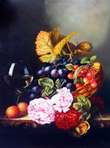A botanical artist is a person who paints, sketches or otherwise illustrates botanical subjects such as trees and flowers. The job requires great artistic skill, attention to fine detail, and technical botanical knowledge. Typical illustrations will be in watercolour, in life size, or if not, the scale shown, and show face and reverse of leaves, flowers, bud, seed and root system. Botanical illustrations can be converted into Botanical oil paintings. It can be expand to wide range of subjects.The use of illustrations was frequently seen in the herbals, seed catalogues and popular works of natural history. The illustrations produced during the eighteenth and nineteenth century are regarded as both appealing and scientifically valid. The finer detail of the printing processes, greatly improving at this time, allowed artists such as Franz and Ferdinand Bauer to depict the minute aspects of the subject. The use of exploded details would further illustrate the description given in the accompanying text. These details allowed a non scientific audience to go some way in identifying the species, the widening interest in natural history and horticulture was an inducement to the production of many Floras and regular publications.
Many books and publication continued to use the artists, even after printed matter began to incorporate photography. It would be many years before the colour printing would equal the artists plates. The accuracy and craft of the artists had developed in tandem with the botanists concerned, the work came to be accepted as important to the botanists and their institutions. The illustrated publication, Curtis's Botanical Magazine (1787), was to eventually appoint an official artist. The 220 year old magazine, long associated with the Linnaean Society and Kew Gardens, is now primarily one of finer botanical illustration. A stream of the finest artists to appear in print have been featured in the magazine.
The contribution of botanical artists continues to be praised and sought, very fine examples continue to be produced. In the 1980s, Celia Rosser undertook to illustrate every Banksia species for the masterwork, The Banksias. When another species was described after its publication, Banksia rosserae, it was named to honour her mammoth accomplishment. Other artists, such as the profuse artist Matilda Smith, have been specifically honoured for this work.
Botanical illustration is sometimes used as a type for attribution of a botanical name to a taxon. The ability of botanists to conserve a dried specimens, or restrictions in safe transport, has meant illustrations have been nominated as the type for that name. Many minute plants, which may only be viewed under a microscope, are often identified by an illustration to overcome the difficulties in using slide mounted specimens. The standards for this are by international agreement (Art 37.5 of the Vienna Code, 2006).
Tags:fine art oil painting, oil paints, oil paintings flowers, impressionists art,

 Fran├зais
Fran├зais Deutsch
Deutsch Espa├▒ol
Espa├▒ol Italiano
Italiano Portugu├кs
Portugu├кs ?ец?му
?ец?му ??ъ╡нь?
??ъ╡нь? ╪з?╪╣╪▒╪и?╪й
╪з?╪╣╪▒╪и?╪й ╨▒?╨╗╨│╨░?╤Б╨║╨╕
╨▒?╨╗╨│╨░?╤Б╨║╨╕ hrvatski
hrvatski Dansk
Dansk Nederlands
Nederlands suomi
suomi ?╬╗╬╗╬╖╬╜╬╣╬║╬м
?╬╗╬╗╬╖╬╜╬╣╬║╬м рд╣рд┐рдиреНрджр?
рд╣рд┐рдиреНрджр? norsk
norsk Polski
Polski Rom├вn?
Rom├вn? ??╤Б╤Б╨║╨╕╨╣
??╤Б╤Б╨║╨╕╨╣ Svenska
Svenska
















